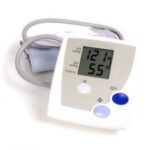A recent clinical vignette in the New England Journal of Medicine touched upon the issue of what blood pressure numbers, i.e. the systolic (top number) and diastolic (bottom number) are considered too high.
Traditionally, hypertension has been defined as either a systolic greater than 140 or a diastolic greater than 90. Though recently these cut-offs have come with some important caveats, for diabetics the blood pressure goal is less than 130/80.
In addition, the range of prehypertension, a systolic of 120 to 139, and a diastolic of 80 to 89, indicates an increased risk of developing hypertension if changes in lifestyle, such as eating healthier diet, reducing weight, and reducing salt in the diet, are not undertaken. Approximately 39% of men and 23% of women in the United States have prehypertension.
Doctors now recognize prehypertension as being abnormal and strongly encourage patients to make changes in their diet and physical activitiy level to avoid hypertension. A patient with prehypertension also has twice the risk of having a heart attack than person with a blood pressure less than 120/80, meaning that prehypertensive blood pressure may be high enough to damage the heart and other organs in the body. Patients with hypertension have approximately four times the risk of having a heart attack.
In addition, children and teenagers with prehypertension are at risk of developing hypertension later in life.
But what if lifestyle changes are not enough? A recent study showed that the treatment of patients with prehypertension by prescribing an antihypertensive medication resulted in a approximately one third reduction in the risk that a prehypertensive person would develop hypertension. The medication used in the study, ramipril, an ACE-inhibitor, was well tolerated by the participants. Given the obesity epidemic, and rising level of hypertension in the United States since 1990, in the near future doctors may begin treating a significant number of prehypertensive patients with medications in order to prevent hypertension. The increasing age of the United States population will mean that hypertension, and its associated medical complications, will become increasingly prevalent.
The risk of hypertension increases with age as well, 10% of 30 years old have hypertension, and 50% of those 60 years and above have hypertension. However this may be due in part to diet rather than just part of the aging process as decreased salt (sodium) intake can keep your blood pressure from rising as quickly. Vegetarians who eat very little salt in their diet don’t normally experience the rise in the blood pressure since in the general population in the United States.
However, The New England Journal of Medicine article stated that a blood pressure with a systolic greater than 115, or a diastolic greater than 75 is associated with an increased risk of heart attacks, strokes, and even cognitive decline. If prehypertension and hypertension both predispose a person to similar health risks, such as heart attacks, then perhaps the definition of hypertension should be changed to incorporate lower systolic and diastolic numbers.
Tackling prehypertension, and hypertension, often requires dietary changes, a brief article I wrote for Associated Content, with links to the DASH diet, is here: http://www.associatedcontent.com/article/5464504/hypertension_and_diet.html?cat=51
Sources:
http://en.wikipedia.org/wiki/Prehypertension
http://content.nejm.org/cgi/content/full/362/22/2102
http://www.webmd.com/hypertension-high-blood-pressure/guide/new-low-for-high-blood-pressure
http://showbizandstyle.inquirer.net/lifestyle/lifestyle/view/20081017-167033/Prehypertension-new-concern-for-doctors



